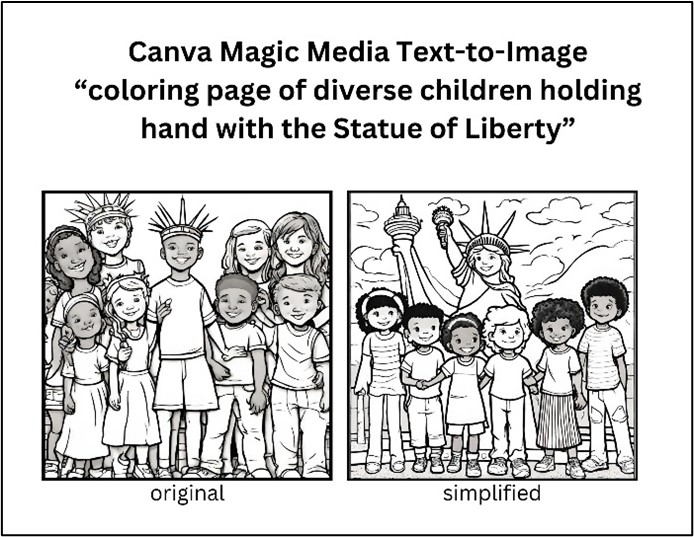Web-Based Class Activities
Here you will find an extensive collection of web-based class activities. These articles provide collections of links to interactive online tools organized around instructional themes and activities. Specific ideas for use in adult education are provided, along with examples and step-by-step instructions.
Using AI Tools in Citizenship Preparation and Civics Education
by Jennifer Gagliardi, OTAN Subject Matter Expert
Civics and citizenship education is vital for fostering active participation and informed decision-making in democratic societies. However, engaging adult learners in this field can pose significant challenges. Enter generative artificial intelligence (AI), offering innovative solutions to revitalize civics education for adult students. Let's explore into how generative AI is reshaping the landscape of adult civics education with practical classroom activities.
Before we begin, I must recommend Lori Howard’s presentations: Using AI to Develop COAAP Instruction and Assessment Tools which addresses civic assessment topics not included in this article but I will be developing later for upcoming workshops 5/9 CCAE State, 5/10 OTAN OTT Webinar, and 6/17 CASAS-SI. See the accompanying article, The New N-400 Application for Naturalization, for a Gen AI activity that re-sequences N-400 2019 material to prepare a citizenship interview based on the new N-400. Join the LINCS Civics Education and Citizenship group for further discussion about the developments of Generative AI in civics education.
Use AI to Generate Questions to Check for Understanding
Civics Education and Citizenship classes rely heavily on videos to quickly immerse students in content. But just because a civics video has color, sound, and audio doesn’t mean the student will get the core intended core content.
Use AI to Generate video-specific questions to check for understanding. Copy and paste a video url into Magic School’s You Tube Video Questions. Chose the grade level of questions, how many questions, and question type. From there you copy and paste the questions and answer choices into another app such as Quizlet, Kahoot, or EdPuzzle; or paste the answer choices only into a form or document, and play the audio only for your students (much like the CASAS 965/966 G/H assessment. Furthermore, you can summarize the answers, and translate them into another language.
Create Web Searches about Different Levels of Government
Students often struggle with the names of elected officials because they are unclear about the roles and responsibilities of different levels of government, the elected officials, and functions of government departments. A simple search engine query will provide an elected official’s name to a test question (USCIS 100:20,23,28,29,40,43,47) which is immediately forgotten, only to be asked again.
Use generative AI to develop a web search that explores different levels of government; share the results via the creation of a common document (which includes the urls as citations). As students gain familiarity, modify the prompt to focus on different government organizations that immediately touch students’ lives such as school boards, transportation agencies, recreational facilities, etc. Students can collate and present their findings via slide decks and videos to encourage public engagement. Directed web searches will create the context needed by students to not only understand the different levels of government, but how to access services and participate in civic life.
Connect Historical Figures Life Lesson to Adult Students’ Lives through Generative AI Interviews
Immigrant students are required to learn about important American historical figures with whom they do not share a cultural or emotional connection. Putting the name and face of American hero on a classroom poster, street sign, or dollar bill is no guarantee that a student will understand the values and historical contributions that are being honored. The key is to find common experiences and struggles that resonate across culture. How many of our adult learners have been denied opportunities because of their country of origin just as Washington was denied a career in the British military because he was colonial-born? How many of our students are still walking, like Harriet Tubman, even though they have crossed over to a “free state?” Teaching students how to use generative AI tools may help students connect on multiple levels.
The initial lesson generated by Humy.AI-generated Harriet Tubman Interview was too juvenile in tone for an intermediate-level English literacy level adult students. Adapting the example from Google Applied Digital Skills: Introduction to Research and Interview a Person from History and supplementing with graphics from NPS.gov: Underground Railroad, more fully informed students of hard details of Tubman’s life. They began to see parallels between her escape and their own immigration journey. Students extended both the historical research and digital skills objectives by submitting the first two interview questions from the above Google Applied Digital Skills: Harriet Tubman (plus added their own clarification questions) to Humy AI Chat with Harriet Tubman which was able to convey to communicate the emotional content that was hidden behind the text and graphics. Because the novelty of using a generative AI chatbot exposed common ground of growth, loss, and the need to carry-on, students emerged from the Humy.AI interview (source: interview transcript) with a much deeper connection with their adopted culture, not only with the historical figure, Harriet Tubman, but with each other.
Promote 2-Gen Civics Learning with Text-to-Image Gen AI Tools
Many Citizenship Preparation classes are hosted in libraries, community centers, and after-hours K12 satellite sites; facilities where adults and children use in common. Maintaining a strict division between adult and children learning opportunities impractical. How do teachers deliver civics content--content that requires the full attention of adults to pass a high-stakes interview--with children in the room? For years, educators sourced patriotic-themed coloring pages, puzzles, and reading lists for children to keep kids busy, never quite closing the generational learning gap. In 2022, USCIS launched the "The Families Learning Civics Together Toolkit" which takes a "2 Gen" or family literacy approach to engage all family members in preparing for naturalization.
While there are several free AI tools that can turn photos into coloring pages, there is still a steep development curve turning text which incorporates both historical content and learners, while matching your current lesson plan and 2-gen goals. True, there are many children's activities devoted to American Symbols, and in particular, dozens of Statue of Liberty coloring pages, but most examples were focus on the Statue alone--a historic relic of past waves of immigration. As part of a lesson on the Oath of Allegiance (one of the last lessons taught in a Citizenship course), I recapped an earlier lesson about symbols, and portrayed the Statue of Liberty as a "living" symbol of welcome, inclusion, and integration of today's immigrants. Using Canva.com Magic Media text-to-image tool, I submitted the prompt: "the Statue of Liberty holding hands with children" (which initially yielded confusing results), then inverted the prompt as "Diverse children holding hands with the Statue of Liberty" which generated coloring pages closely aligned to civic objectives and family literacy goals. Families were "enlightened" and encouraged by the results.


News and Media Literacy for Informed Voters
News and Media Literacy is set of a critical thinking and digital skills used to gauge the credibility of information. Generative AI tools can be used to subtly change facts and photos from authoritative sources to factoids and images created to spread misinformation and manipulate audiences. While there are several go-to resources for lesson plans such as Center for News Literacy, Common Sense AI Literacy Lessons, VOA Learning English News Literacy, organizations as varied as AARP, PBS, and the Brennan Center for Justice’s AI and Democracy all warn against the proliferation of “pink slime sites” which masquerade as local news sites (with hidden partisan agendas) that misdirect their readers and suppress the vote.
Into the civic/edtech breach steps News Lit: Election 2024: Be Informed Not Misled (formerly Checkology); its project, “Rumor Guard,” which features a screenshot of the rumor as it has circulated online and an analysis of why is false based on 5 factors: Source, Evidence, Context, Reasoning and Authenticity; NewsLit’s weekly newsletter “The Sift”. One recent issue of The Sift featured three simple strategies to identify misinformation: false context, manipulated images, and imposters plus a misinformation quiz which can be easily replicated by teachers and students focus on the 2024 Election substituting in their own true/fake media from local/national/international news sources. Developing critical thinking, new, media, and digital skills supports student autonomy and an informed electorate.
Conclusion
In conclusion, the incorporation of generative AI holds immense promise for revitalizing adult civics education and empowering adult learners to become active, informed citizens. By embracing innovative AI-driven approaches, educators can inspire curiosity, foster critical thinking, and cultivate a deeper understanding of civic responsibilities among adult students. As the Great Wave of Generative AI swells to smash all in its path, even the Mt. Fuji of American adult education, let us be prepared to ride wave towards a more inclusive, participatory, and civically engaged society.

Source: Great Wave of Gen AI by Jennifer Gagliardi using MS Designer Image Creator 04/18/2024 (inspired by Hokusai’s The Great Wave off Kanagawa)
Resources for Further Consideration:
CASAS Competencies Essential Life and Work Skills for Youth and Adults (Competency 5: Government and Law)
CrowdED Learning: Subject Area Frameworks for Adult Learners (Civics slides 5-7)
OTAN: Digital Guidance: Chapter 3 – Foundations of Adult Education and Digital Learning
OTAN: Video Presentations: AI (more coming soon!)
LINCS: EARN: Rights and Responsibilities of Citizenship and Civic Participation
LINCS: Teaching Skills that Matter: Civics Education
World Ed’s EdTech Center: GenAI Resources for Educators


